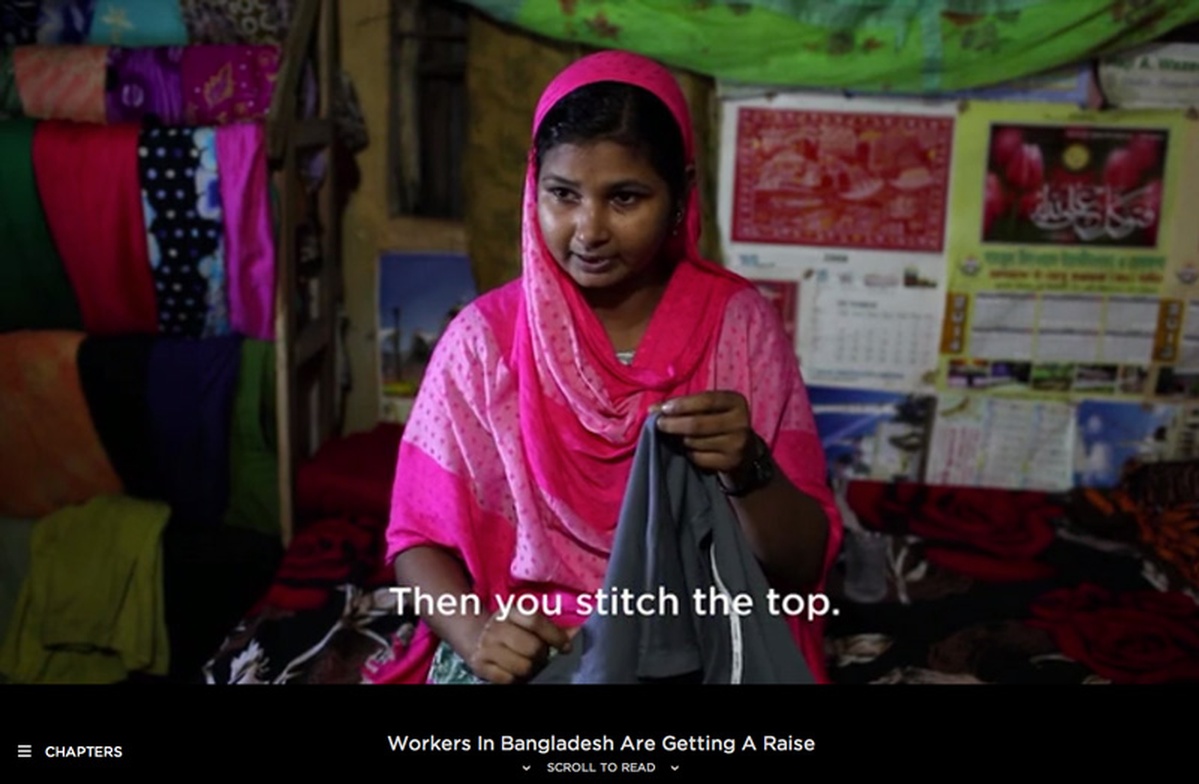Features:
Collaborating on the T-Shirt Project
Planet Money + the NPR Visuals team

From the video narrative of the People chapter of Planet Money Makes a T-Shirt
Back in April of this year, NPR’s Planet Money began a Kickstarter campaign to learn about and report on global supply chains by making a t-shirt and telling the story of its creation from start to finish. The Planet Money team sought $50,000 to fund the project and received nearly $600,000, allowing them to expand the scope of their reporting and presentation. The newly combined News Apps and Multimedia teams at NPR collaborated on the project’s web manifestation, which went live last night. The technical details of the project are forthcoming, but the source code is already on GitHub, and we spoke with team lead Brian Boyer about the collaboration just before Thanksgiving. The following is a lightly edited transcript of our conversation.
Origins and Process
Source: Can you tell us how this project got started and how your team got involved?
Boyer: [Planet Money] wanted to tell the story of the a t-shirt. It’s a supply chain story, but told through something we’re intimately—it’s something that’s on our backs, something I wear every day. We were initially going to be involved in a small way—helping with building the website, presenting the photography and video they were taking. Our team became more involved as the project grew. We realized we had a ton of amazing stuff, so we decided…let’s do it up.
This is the first project of the combined [NPR] News Apps and Multimedia teams, so for me, this has been a great learning experience about how folks who produce video, take pictures, and make pictures work. We’ve been holed up in a little tiny conference room, for more than a month now—after the video and photography had been shot and the reporting done, we’ve been camped out in our war room to bring it all together.
How did you work with the Planet Money team?
We’ve worked very closely with them, which can be difficult because they’re remote—they’re in New York. I like to run a pretty tight process, your stakeholders need to be pretty intimately involved. Alex Blumberg, Josh Davis, Jacob Goldstein and other folks have been coming down to DC almost weekly for our reviews, and we’ve been using tools like Basecamp and group chat software and GitHub.
Challenges

What were the biggest technical or design challenges your team dealt with?
There were several challenges. We wanted to make—I think initially I was thinking about this like some of the projects the [New York] Times has been doing, using video to sort of set a mood and integrating text and video together, and then we realized pretty early on that that wasn’t the way this needed to be told. Largely because our strengths are in the narrative, so playing to our strengths and building something that’s much more of a web-native documentary. I don’t even like the word documentary, but what’s the narrative web video format that is better than just embedding a YouTube video at the top of a post? And how can we play to our strengths at narrative, like Alex’s voice, but then also use the other media at hand to their best abilities—integrating charts, integrating animated GIFs? (Actually, there are things that look like animated GIFs but that are in fact not, they’re things we’re calling filmstrips. They’re actually just tall JPEGs—we’ll probably write a Nerd Blog post about that technique. And they compress, because GIFs just don’t compress well.)
There were a lot of parts of the story that were going to be better told with words, and then the heart and soul of the story, the story of Jasmine and Doris, the two people whose hands actually made your shirt, we’re telling with video. What video’s great at is bringing you in, producing empathy in a way that the text and charts can’t do. It’s hard to do empathy in an infographic.
We’ve been trying to learn from what folks have done before, and also figure out the best use of the tools we have. I wouldn’t want to say we’re, you know, one-upping some of the Times productions—we’re just different. It’s a differently shaped thing, though we initially thought it would be shaped more like that, or at least that was what I was thinking. But the team convinced me otherwise.
It’s been tremendous—in a lot of ways, I’m just helping coordinate this, it’s really the folks on the team who deserve all the credit. I’ve been involved, but they made it. We’ll be getting some Nerd Blog posts out of this one!
People
Organizations
Code
Credits
-
 Brian Boyer
Brian Boyer
Brian is an independent consultant. Previously, he was the vice president of product and people at Spirited Media, the visuals editor at NPR, founded the news applications team at the Chicago Tribune, and was a happy intern at ProPublica. He was one of the first programmers to receive a Knight-funded scholarship to study journalism at Northwestern University.
-
 Erin Kissane
Erin Kissane
Editor, Source, 2012-2018.



